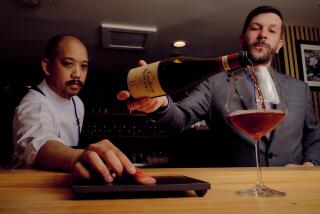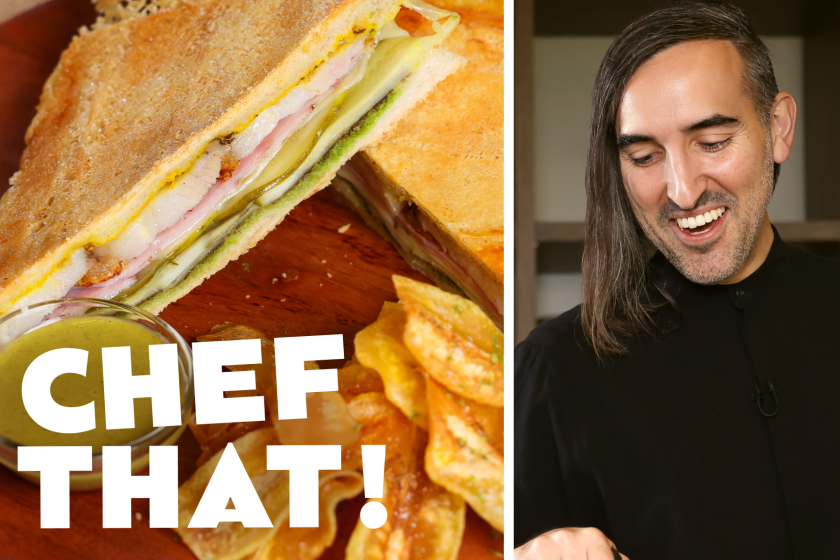Triple Crown of Wines
If price were an accurate indication of a wineâs quality, wine buying would be a science. Instead, choosing a bottle off a shelf is closer to handicapping horse races.
This is to say that itâs far from a sure thing. But itâs not all luck, either; you can assess the field. And there is such a thing as inside knowledge.
In fine wines, as in racehorses, breeding counts. Good wines have track records: good bloodlines (vineyards), trainers (winemakers) and past performances (vintages). Whatâs more, there are always up-and-comers.
The great New Yorker writer A.J. Liebling once celebrated a fellow named Tex (real name: Augustine J. Grenet), who was the leading horse-racing bookmaker in the early part of this century. He was something of a human calculating machine.
Said Liebling: âTex believes that horse racing, like history, moves in cycles and that everything that happens on a race course is bound to recur. Since he forgets nothing, each year adds to his estimative equipment.â
Iâm no Tex and I do forget all kinds of things, but I agree with Texâs world view. Everything that happens in wine--such as good vineyards and high-minded producers--is bound to repeat itself. And I do flatter myself to think that every year adds to my âestimative equipment.â
The following three wines, dark horses all, are more than merely good bets. If my equipment is working, theyâre very nearly sure things.
* 1994 Foris Vineyards Gewurztraminer ($8.50): Of all white wine grapes, Gewurztraminer may be the trickiest, both to grow and to make into wine. The reason is Gewurztraminerâs inherent spicy taste. (Gewurz is German for âspice.â As for the traminer part of the name, it derives from the village of Tramin, in what is now the Italian Tyrol, where the variety was first cultivated nearly 1,000 years ago.)
To grow Gewurztraminer, you need a very particular climate that preserves the spicy taste of the grape. Generally, cooler is better than warmer. In making the wine, you need to preserve the spiciness without amplifying it so much that the wine becomes painful to drink.
The problem is that this spicy taste can easily become too pronounced. When Gewurztraminer goes over the top, itâs just too intense, too spicy, too redolent of litchi nuts. Gewurztraminer should deliver its characteristic spiciness in measured amounts.
Above all, you want a sense of delicacy and finesse. Even a variety as vocal as Gewurztraminer should seduce rather than bully.
Success at this feat will result as much from the vineyardâs location as from the winemakerâs manipulations. Itâs no coincidence that Californiaâs two best spots for growing Gewurztraminer are two of its coolest wine districts: Mendocino Countyâs Anderson Valley and Sonoma Countyâs Russian River Valley.
Foris Vineyards, however, is in Cave Junction, Ore., just across the border from California. This helps to explain the terrific price. Oregon wineries in general--and southern Oregon wineries in particular--are still struggling for recognition, especially for any grape other than Pinot Noir.
Throughout Oregon, the 1994 vintage was one of the best ever. And the harvest conditions in southern Oregon were ideal for growing Gewurztraminer. As a result, this is a superb example: fully dry, spicy yet balanced and graced with finesse.
Its restraint makes the wine effortlessly drinkable, an ideal accompaniment to anything containing cooked onions (Gewurztraminer is delicious with onion soup or onion tart) and strong cheeses such as Muenster. Not least, itâs a good sunset sipper. Look for it to be discounted as low as $6.95, which makes it an unbeatable bargain.
* 1994 Ciro Rosso Classico, Librandi ($8.95): Iâve served various vintages of this always reliable Italian red wine to guests, and the response has always been the same: This is delicious--what is it?
For starters, Ciro (pronounced chee-ROE) is not a brand name but the name of a small wine district in Calabria, the toe of the Italian boot. (Actually, Ciro is on what might be described as the ball of the foot.) The grape is Gaglioppo, an indigenous grape of Calabria and one of those hundreds of red varieties found in Italy and nowhere else. One taste and you know it could only be Italian.
What makes Ciro so good--at least in the hands of the winegrower, Antonio Cataldo Librandi--is that it delivers a mouthful of flavor. Itâs soft and rich and slides down the gullet without a catch. Best of all, itâs not quite like any other red wine, even though thereâs a certain Italianate familiarity in its earthiness.
This is the sort of red that you serve with all kinds of meats, especially grilled or barbecued. It is distinguished enough to be poured at a formal dinner, yet it manages to be ideal for an outdoor picnic. Not every good red wine can pull that off. Several friends have made it their house red.
Look for a street price as low as $6.95. Also, vintages donât matter much with this wine. So if you see a 1992 or â93 Ciro, theyâre swell too. This wine ages gracefully, though it really doesnât need any cellaring.
* 1993 Argyle Dry Riesling ($9.95): No white wine is more overlooked, or undervalued, than dry Riesling. When grown in the right place, though, a good dry Riesling can make you sit up and take notice. Not least, it probably goes with more foods more successfully than any other dry white wine. (Yes, including Chardonnay.)
In Alsace, where dry Riesling is king, it is served with all sorts of sausages, especially the light-colored sorts made with veal and pork. Wine connoisseurs in Paris choose dry Riesling as their accompaniment to shellfish.
Rieslingâs greatness is revealed by its ability to transform with age. A really fine dry Riesling--and this is one, by the way--can improve for up to 15 years in a cool spot. There is still some â91 on the market; if you see it, snap it up. That said, itâs always a pleasure to drink young and fresh. Rieslingâs virtues cannot be sung too often, especially at the right price.
Argyle (which is the label name for the Dundee Wine Co.) is in the northern part of Oregonâs Willamette Valley, a 100-mile-long stretch of green between Eugene and Portland. Although sparkling wines are Argyleâs specialty, for this taster Argyleâs dry Riesling is its best wine. In a word, itâs a stunner.
As do the previous vintages, Argyleâs 1993 dry Riesling comes from a single vineyard of older vines. Surely this helps explain its exceptional concentration and character. Riesling is notorious for high yields: In Alsace and Germany, itâs not unusual to get 6 or 7 tons of grapes from an acre. Argyleâs vineyard yields just 2 1/2 to 3 tons an acre.
In addition, the Willamette Valley is an ideal location for growing Riesling; its long, cool autumns foster the varietyâs late-ripening tendency. Unfortunately, because Riesling prices are derisively low, growers are fast uprooting the plantings dating from the early â70s, when Riesling was more appreciated. This is true everywhere on the West Coast.
Simply put, Argyle Dry Riesling 1993 is one of the Americaâs best dry white wines, yet you can find it at a street price as low as $7.95 a bottle. Donât let that distort your estimation of it. In a just world--for winegrowers, anyway--its price should be twice what it fetches. For wine lovers, though, the bargain price is a clarion call to get it while the getting is good.
By the way, this is an ideal dry white wine to put away in a cool spot for future drinking. Experience reveals that it will do nothing but improve for as long as a decade. No one will believe how little you paid when they taste this wine a few years from now.
More to Read
Eat your way across L.A.
Get our weekly Tasting Notes newsletter for reviews, news and more.
You may occasionally receive promotional content from the Los Angeles Times.










